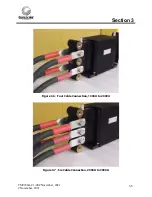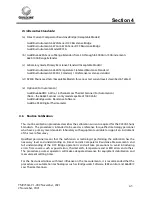
Section 3
TM9230A-C1-002 November, 2021
2 November, 2021
3-11
3.6
Custom Values
Any custom value is available upon request. For custom values, to determine the uncertainy, use the
closest nominal value listed in the specification table. Actual measurements and associated
uncertainties will be listed on the calibration certificate and report of calibration.
It is important to consider both the maximum test current requirement and the power dissipation that
will be realized for a specific resistance value. Where a specific potential voltage is required for full scale
current it is important to consider the power that will be dissipated by the shunt at full scale current. The
following formulae are usefull in this respect.
Power dissipation based on resistance and full scale current;
Power Dissipation = (Maximum Current)
2
x
Shunt Resistance
For a shunt with a resistance of 1 m
Ω
and a full scale current of 300 A, 90 Watts will be
dissipated by the shunt.
Power dissipation based on resistance and full scale potential;
Power Dissipation = (Maximum Voltage)
2
/
Shunt Resistance
For a shunt with a resistance of 10 m
Ω
and a full scale potential of 1 V, 100 Watts will be
dissipated by the shunt.
Shunt resistance based on potential voltage and power dissipation;
Shunt Resistance = (Maximum Voltage)
2
/
Power Dissipation
For a shunt with a full scale voltage of 0.75 volts and a maximum power dissipation level
of 112.5 Watts, the shunt will have a resistance value of 0.005 ohms.
Shunt resistance based on full scale current and power dissipation;
Shunt Resistance = Power Dissipation
/
(Maximum current)
2
For a shunt with a full scale current of 1500 A and a maximum power dissipation level of
112.5 Watts, the shunt will have a resistance value of 0.00005 ohms, (0.05 m
Ω
).
Summary of Contents for 9230A Series
Page 2: ......

























